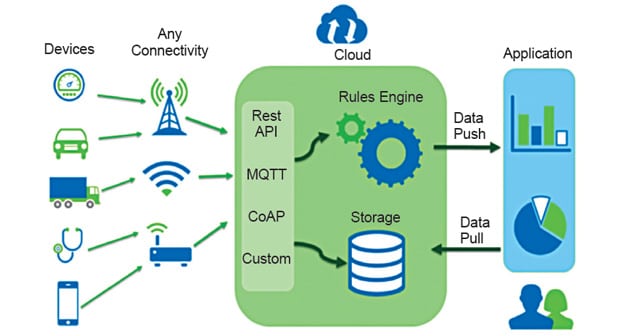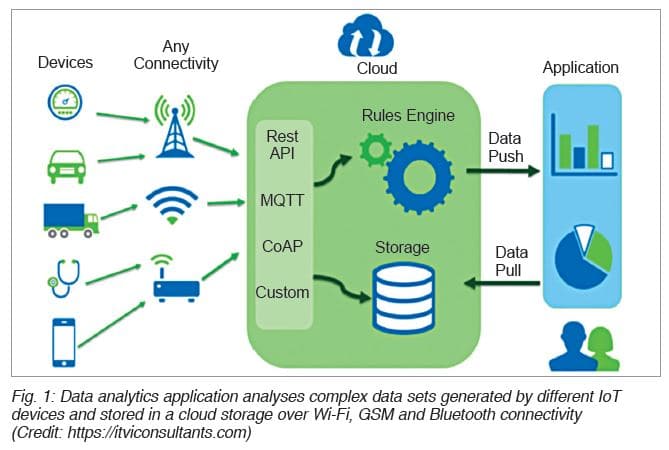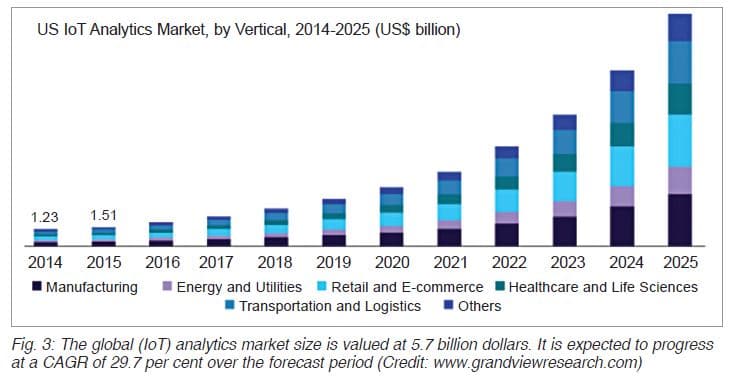- Contact Us
- +91-98111-55335
- [email protected]

Electromagnetic Interference And Compatibility: Indian Scenario
July 13, 2020
“Everything… Is Automated Now”
July 13, 2020IoT Creating New Avenues For Data Analytics

An IoT solution is incomplete without in-built data analytics as a part of the user application layers. Customers look for an effortless way to know the insights from data collected by the IoT hardware using sensors. The greatest value lies in how businesses apply IoT, learn from the data captured, and improve efficiencies
The Internet of Things (IoT) is a network of ‘things’ with in-built intelligence to sense, store and exchange information with mobile phones, machines, smart homes, vehicles, electronic devices, etc. It is a part of the fourth industrial revolution, which is basically an evolution of mobile and embedded technologies with connectivity to the Internet, integrating greater computing and analytic capabilities. International Data Corporation (IDC) says, “There will be 41.6 billion connected devices, generating 79.4 zettabytes (ZB) of data by 2025.”
With billions of devices connected to the Internet and hundreds of billions of people exchanging information with devices, these can become an intelligent network of systems. These systems, when sharing data over the cloud, can transform products, businesses, and lives in countless ways—whether it’s fast medical service, better education, lower transportation costs, or optimising energy generation and consumption.
IoT technology stack
The IoT technology stack contains five different layers, including hardware, device software, communication, cloud, and user applications. The whole stack is required to work in sync to benefit from the IoT technology.
The hardware layer contains the microcontroller, necessary sensors, and peripherals suitable for the product. The device software layer guides the hardware to function as per specifications. It is basically a firmware enabling the hardware. The communication layer implements Internet connectivity using wireless protocols like Bluetooth, Wi-Fi, or GSM based on the range, bandwidth, and connectivity requirements of the device.
The cloud provides additional storage along with local onboard storage to achieve anytime access, data security, and unlimited extendible storage. The user application layer is key to the success of the product as customers get a feel using it. A user can be a chief technology officer (CTO), analysing a dashboard to understand average defect rate, machine breakdowns, and production numbers, or a software engineer at the office checking what’s the average temperature at home to switch on AC or geyser using a mobile app.

Data analytics
After IoT data analysis, businesses can develop machine learning (ML) models and implement them as part of the IoT solution infrastructure so that action is taken without any human intervention when a similar pattern arises in the data generated in real time. ML trains machines on how to respond to a combination of inputs, even unknown inputs, and ensure a steady and accurate output. It involves performing data modelling on the data collected by IoT sensors, followed by creating an ML model using statistical or mathematical algorithms. These models are deployed and used until they ensure high accuracy.

In healthcare, the IoT revolution is driving new equipment, remote monitoring, and wearables to constantly monitor the health of individuals. Performing data analytics can help draw useful insights from the data like heart rate pattern, SO2 oxygen pattern, and average body temperatures. Based on these vitals, doctors can predict symptoms of disease well in advance.

“You can have data without information, but you cannot have information without data,” says Daniel Keys Moran, an American fiction writer and computer programmer. IoT is key to look deep into processes and generate related data, whereas analytics is a must to dive deep into data to produce useful insights. IoT and analytics remain connected and grow together.
IoT analytics
IoT analytics emerged for crunching the IoT data. It refers to data tools used to draw values from Big Data generated by the IoT. A lot of companies implement IoT technology to gather data from sensors placed on solar panels, delivery trucks, machinery, and human bodies. A lot of related data comes from gateways, data storage, and network devices. IoT data is streamed at high volumes and high data rates continuously and considered a special case of Big Data.
These streams of data are combined and transformed to present consumable reports. IoT’s real-time processing and insights help companies make better marketing and operational decisions. IoT data poses challenges, including data integration, compatibility, and data analytics, which are well addressed using IoT analytics.
Analysts estimate the IoT analytics market to grow at a CAGR of 29.7 per cent by 2025, at a valuation of 5.7 billion dollars. While smart cities, smartwatches, and other ‘smart’ initiatives are driving IoT adaption, social media, mobile, Internet, and IoT itself are driving the IoT analytics.
—Rajesh Kumar Adla is the founder of Null Innovation Inc. with over ten years of experience in product development. He has previously worked as an L6 leader at Amazon, delivering fulfilment technologies
for Amazon Pantry
